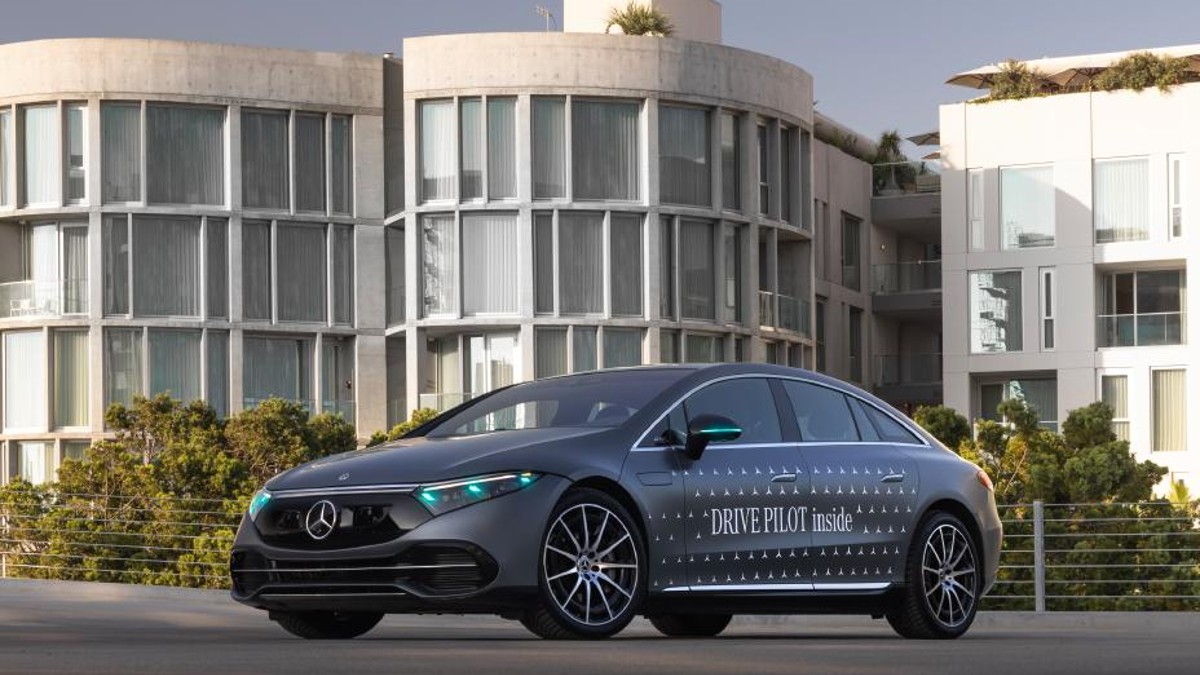
Red means stop, green means go – and turquoise now means automated driving: Mercedes-Benz is the first automaker permitted to use exterior marker lights, which means automated driving is activated, in California and Nevada.
Turquoise is the color
In California, Mercedes can now test turquoise marker lights for automated driving – its DRIVE PILOT system – on freeways. The unique marker lights are integrated into the EQS’s front and rear lights and the two outside mirrors in testing cars.
In Nevada, the permit allows production cars to be equipped with marker lights, beginning with the 2026 Mercedes-Benz EQS, until legislative changes occur.
Mercedes says the exterior turquoise lights (pictured above) let the public and police know that the EQS’s automated driving system is switched on. (That way, drivers don’t get in trouble with the law for doing other things besides steering the car.)
Mercedes chose the color turquoise for two main reasons – its visibility and the fact that the color isn’t used by existing vehicle lighting, traffic lights, or emergency lighting. (Mercedes notes that the marker lights are designed in accordance with SAE J3134 Recommended Practice.)
Markus Schäfer, Mercedes-Benz’s chief technology officer, development & purchasing, said:
With the development of automated driving marker lights, Mercedes-Benz is once again setting new industry standards. We are the first automaker in the world to receive such approvals in the US, specifically in California and Nevada.
The more automated driving vehicles populate the road, the more important communication and interaction between the vehicle and the environment become.
As my colleague Jameson Dow explained when he test drove the EQS’s DRIVE PILOT system in September, it’s the first hands-free Level 3 autonomous drive system certified to operate in the US:
Autonomous drive systems are ranked from level 0-5, describing how much capability the system has. In general, levels 0-2 are primarily human-driven, and levels 3-5 are primarily autonomously driven.
What [Level 3] means is this is the first system in the US that is actually validated to take full control of the vehicle, under certain circumstances, freeing you to do other tasks than driving.
This is a fledgling technology – it was first made available for order in Germany last year – so while DRIVE PILOT is a trailblazer, it still has limitations. Level 3 is conditional automation, meaning it only works within Mercedes’ “Operational Design Domain.” That means heavy traffic conditions under 40 mph with a lead car available, good weather, good road conditions, and only in well-mapped areas. The driver also needs to be able to take the wheel when the car tells you to.
Photo: Mercedes-Benz
Electrek’s Take
When you drive near student drivers, the car is marked in some way to let you know that an inexperienced driver has the wheel. It’s a heads-up.
So, it makes sense that, eventually, all Level 3 automated driving EVs have their own heads-up: standardized lighting that comes on when it’s piloting itself. In fact, it should be required.
Top comment by Zzyzx
Any vehicle using level 2 or higher ADAS should have to have indicators to alert other drivers. Be it SuperCruise, BlueCruise, Tesla's Autopilot or FSD. Having personally been in a Tesla on FSD when it attempted to drive into a traffic sign on a trailer, it should be required to alert others on the road when a driver has activated any ADAS system. The quote about FSD being equivalent to a 14-year old that happens to use hard drugs always resonates with me. My best friend will never use FSD on city streets as he has a firm belief the system is always looking for ways to kill him.
So, perhaps turquoise will become the standard color for automated driving, as Mercedes has proposed. A lot of different players will have to buy in.
Click here to find a local dealer with the Mercedes-Benz EQS in stock.–affiliate link*
To limit power outages and make your home more resilient, consider going solar with a battery storage system. In order to find a trusted, reliable solar installer near you that offers competitive pricing, check out EnergySage, a free service that makes it easy for you to go solar. They have hundreds of pre-vetted solar installers competing for your business, ensuring you get high-quality solutions and save 20-30% compared to going it alone.
Plus, it’s free to use, and you won’t get sales calls until you select an installer and share your phone number with them. Your personalized solar quotes are easy to compare online, and you’ll get access to unbiased Energy Advisers to help you every step of the way. Get started here. – ad*
FTC: We use income earning auto affiliate links. More.



Comments